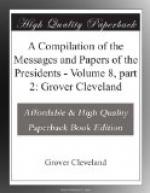As there does not appear from the bill to be any beneficiaries in existence to which this endowment can be applied, each State is required “to provide, within five years at least, not less than one college, or the grant to said State shall cease.” In that event the “said State shall be bound to pay the United States the amount received of any lands previously sold, and that the title to purchasers under the State shall be valid.”
The grant in land itself is confined to such States as have public lands within their limits worth $1.25 per acre in the opinion of the governor. For the remaining States the Secretary of the Interior is directed to issue “land scrip to the amount of their distributive shares in acres under the provisions of this act, said scrip to be sold by said States, and the proceeds thereof applied to the uses and purposes prescribed in this act, and for no other use or purpose whatsoever.” The lands are granted and the scrip is to be issued “in sections or subdivisions of sections of not less than one-quarter of a section.”
According to an estimate from the Interior Department, the number of acres which will probably be accepted by States having public lands within their own limits will not exceed 580,000 acres (and it may be much less), leaving a balance of 5,480,000 acres to be provided for by scrip. These grants of land and land scrip to each of the thirty-three States are made upon certain conditions, the principal of which is that if the fund shall be lost or diminished on account of unfortunate investments or otherwise the deficiency shall be replaced and made good by the respective States.
I shall now proceed to state my objections to this bill. I deem it to be both inexpedient and unconstitutional.
1. This bill has been passed at a period when we can with great difficulty raise sufficient revenue to sustain the expenses of the Government. Should it become a law the Treasury will be deprived of the whole, or nearly the whole, of our income from the sale of public lands, which for the next fiscal year has been estimated at $5,000,000.
A bare statement of the case will make this evident. The minimum price at which we dispose of our lands is $1.25 per acre. At the present moment, however, the price has been reduced to those who purchase the bounty-land warrants of the old soldiers to 85 cents per acre, and of these warrants there are still outstanding and unlocated, as appears by a report (February 12, 1859) from the General Land Office, the amount of 11,990,391 acres. This has already greatly reduced the current sales by the Government and diminished the revenue from this source. If in addition thirty-three States shall enter the market with their land scrip, the price must be greatly reduced below even 85 cents per acre, as much to the prejudice of the old soldiers who have not already parted with their land warrants as to Government. It is easy to perceive that with this glut of the market Government




